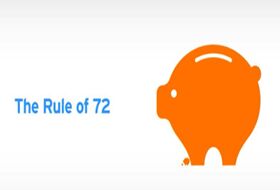理财必看的72法则
|
If there's one thing you want to be sure of when it comes to investing and retirement planning, it's that you'll have enough money to meet your financial needs over the long-term. Part of retirement planning and investing involves making calculations to see how likely--and how quickly--your money is to grow over time. Compound interest is an amazing thing, and the Rule of 72 is a simple way to quickly estimate how long it will take your investment to double in size, assuming you reinvest any dividends. It's a helpful way to put the time value of money into perspective as you map your retirement and investing strategies. Another upside is that utilizing this rule is relatively simple. The only piece of information you need to complete the Rule of 72 calculation is the annual rate of return on your investment. Although, you'll probably also want to use a calculator to run the numbers.
One thing to note: the Rule of 72 works best for investments that have a fixed rate of return. While most investments don't have a fixed rate of return over a long period of time, you can use an average estimate to get a pretty good idea of how long it will take you to double your money. How to Use the Rule of 72 If you're ready to put the Rule of 72 to work, here's what to do. To estimate how long it takes for your money to double, simply divide 72 by the interest rate. The result is how many years it will take for your money to double at that rate. For example, let's assume you can earn a 6% rate of return. How long will it take $1,000 to grow into $2,000? Here's the equation: 72 / 6 = 12 years In this example, if you invested $1,000 into an account that earned a flat 6% annual rate of return, after 12 years, your investment would be worth around $2,000. That's a simple way to calculate earnings but it can be powerful for determining whether there's a gap or potential shortfall in your savings strategy. The Rule of 72 can help you gauge whether your current savings plan is sufficient for reaching your short- and/or long-term goals. The Rule of 72 by Interest Rate Since interest rates can vary, the Rule of 72 calculation can produce different results, based on what you've invested in. To save you a little time, here are some common interest rates, plus the amount of time it will take for you to double your investment with each interest rate: 1% - 72 years 2% - 36 years 3% - 24 years 4% - 18 years 5% - 14 years 6% - 12 years 7% - 10.3 years 8% - 9.0 years 9% - 8.0 years 10% - 7.2 years 11% - 6.5 years 12% - 6.0 years Remember, It's Just an Estimate Keep in mind that this is just a quick estimate. Depending on changes in the rate of return over time, what you're invested in, how you invest it, how interest is applied, and possible tax implications, the actual amount of time needed to double your money will vary. Even so, the rule of 72 can be helpful when you quickly want to compare the rate of growth of two investments. You can easily see at a glance which one is likely to yield a better rate of return to decide where the best place is to allocate your money. The rule of 72 also works in reverse — it can be helpful in understanding the power of inflation. If you consider the average long-term rate of inflation is between 3% and 4%, you'll notice when you use the rule of 72 that something worth $100 today will cost $200 in about 20 years. This can help illustrate the power of inflation, which can have a significant impact on your retirement strategy. And, the Rule of 72 is also useful in realizing a rate of return over time that can not only overcome inflation, but also taxes, which can take a bite out of your investments and retirement income. |









